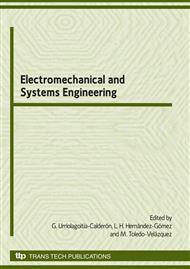p.55
p.61
p.67
p.73
p.81
p.89
p.95
p.103
p.109
Stress and Vibration Analysis of a Lathe Bed Made of Aluminum-Copper Alloy for High Speed Machining
Abstract:
The analysis of the rigidity of an Al-Cu alloy lathe bed to be used for high speed machining (HSM) is presented in this work. Mechanical design optimization by means of simulations based on the finite element method (FEM) was applied in order to calculate the lathe bed deflections, the natural frequencies and the corresponding vibration amplitudes. For the parametric modeling, a prototype lathe to be used in conventional speed machining (CSM) with a cast iron bed was considered. The optimized parameter was the stress in the lathe bed, considering as a restriction the allowable deflection in a node of the machine-tool structure. The design variables were the height, the thickness, and the length of the wall of the lathe bed. The lathe bed was loaded with cutting and inertial forces due to HSM in order to demonstrate that the evaluated stresses and vibration amplitudes are in an acceptable level according to ISO Standards (system of limits and fits in workpieces). The results show the feasibility of using an Al-Cu alloy instead of cast iron in the fabrication of lathe beds. This increases the flexibility of manufacture.
Info:
Periodical:
Pages:
81-88
Citation:
Online since:
August 2009
Price:
Сopyright:
© 2009 Trans Tech Publications Ltd. All Rights Reserved
Share:
Citation:


